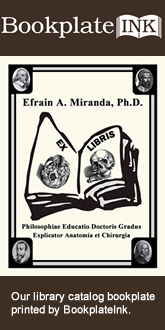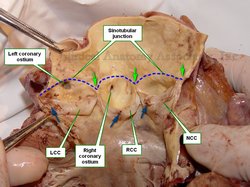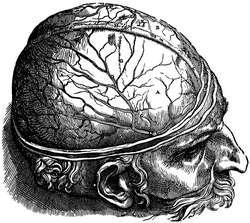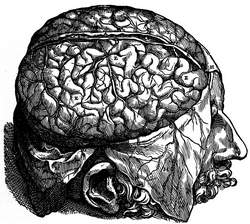
Medical Terminology Daily (MTD) is a blog sponsored by Clinical Anatomy Associates, Inc. as a service to the medical community. We post anatomical, medical or surgical terms, their meaning and usage, as well as biographical notes on anatomists, surgeons, and researchers through the ages. Be warned that some of the images used depict human anatomical specimens.
You are welcome to submit questions and suggestions using our "Contact Us" form. The information on this blog follows the terms on our "Privacy and Security Statement" and cannot be construed as medical guidance or instructions for treatment.
We have 300 guests online

Georg Eduard Von Rindfleisch
(1836 – 1908)
German pathologist and histologist of Bavarian nobility ancestry. Rindfleisch studied medicine in Würzburg, Berlin, and Heidelberg, earning his MD in 1859 with the thesis “De Vasorum Genesi” (on the generation of vessels) under the tutelage of Rudolf Virchow (1821 - 1902). He then continued as a assistant to Virchow in a newly founded institute in Berlin. He then moved to Breslau in 1861 as an assistant to Rudolf Heidenhain (1834–1897), becoming a professor of pathological anatomy. In 1865 he became full professor in Bonn and in 1874 in Würzburg, where a new pathological institute was built according to his design (completed in 1878), where he worked until his retirement in 1906.
He was the first to describe the inflammatory background of multiple sclerosis in 1863, when he noted that demyelinated lesions have in their center small vessels that are surrounded by a leukocyte inflammatory infiltrate.
After extensive investigations, he suspected an infectious origin of tuberculosis - even before Robert Koch's detection of the tuberculosis bacillus in 1892. Rindfleisch 's special achievement is the description of the morphologically conspicuous macrophages in typhoid inflammation. His distinction between myocardial infarction and myocarditis in 1890 is also of lasting importance.
Associated eponyms
"Rindfleisch's folds": Usually a single semilunar fold of the serous surface of the pericardium around the origin of the aorta. Also known as the plica semilunaris aortæ.
"Rindfleisch's cells": Historical (and obsolete) name for eosinophilic leukocytes.
Personal note: G. Rindfleisch’s book “Traité D' Histologie Pathologique” 2nd edition (1873) is now part of my library. This book was translated from German to French by Dr. Frédéric Gross (1844-1927) , Associate Professor of the Medicine Faculty in Nancy, France. The book is dedicated to Dr. Theodore Billroth (1829-1894), an important surgeon whose pioneering work on subtotal gastrectomies paved the way for today’s robotic bariatric surgery. Dr. Miranda.
Sources:
1. "Stedmans Medical Eponyms" Forbis, P.; Bartolucci, SL; 1998 Williams and Wilkins
2. "Rindfleisch, Georg Eduard von (bayerischer Adel?)" Deutsche Biographie
3. "The pathology of multiple sclerosis and its evolution" Lassmann H. (1999) Philos Trans R Soc Lond B Biol Sci. 354 (1390): 1635–40.
4. “Traité D' Histologie Pathologique” G.E.
Rindfleisch 2nd Ed (1873) Ballieres et Fils. Paris, Translated by F Gross
"Clinical Anatomy Associates, Inc., and the contributors of "Medical Terminology Daily" wish to thank all individuals who donate their bodies and tissues for the advancement of education and research”.
Click here for more information
- Details
[UPDATED] These two terms are synonyms, but they have different etymology. [Stenosis] arises from the Greek [στενός] (stenos) meaning "narrow". Since the suffix [-osis] means "condition of", the word [stenosis] means a "condition of narrowing".
The synonym [stricture] arises from the Latin term [strictus] meaning "narrow", "restricted" or "constriction". Both terms refer to the narrowing of an anatomical structure, as in "coronary artery stenosis", or the "stenosis of an anastomosis".
A common mistake is to confuse [stenosis] and [stricture] with "blockage" or "obstruction". Although an stenotic vessel is partially obstructed, there is still flow and it is not a complete obstruction.
Sources:
1. "The Language of Medicine" John H. Dirckx Pub: Harper & Row 1976
2. "Medical Meanings" Haubrich, William S. Am Coll Phys Philadelphia 1997
3. "The origin of Medical Terms" Skinner, AH, 1970
Note: The links to Google Translate in these articles include an icon that will allow you to hear the Greek or Latin pronunciation of the word.
- Details
UPDATED: The root term [-gnos-] has origin in the Greek word [γνώση] (gn??si?) meaning "knowledge". Here are two terms that use this root in medical terminology:
- Diagnosis: the prefix [dia-] means "complete" or "total". The suffix [-(o)sis] means "condition" or "situation". The word means "a situation of complete knowledge", referring to the clear identification of a pathology that ails a patient.
- Prognosis: the prefix [-pro-] means "forward". The terms means "forward knowledge" and refers to the clinical pathway of a pathology and/or treatment.
- Details
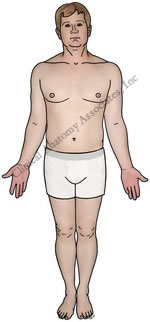
Anatomical position
The use of directions when working with the human body can be problematic, if not critical. When a surgeon indicates to his assistant to "cut towards the left", whose left is he referring to? the assistant's left? the anesthesiologist's left? the surgeon's left?. This is even life-threatening if we are talking about a pneumonectomy, a nephrectomy, or any surgical manipulation of a bilateral organ.
The situation is complicated by the position of the patient on the surgical table. If the patient is prone (face down) where is "down"? What if the patient is placed in a reverse Trendelenburg position? The examples of directional mistakes can go on and on, and they are in many cases cause for problems.
The need for specific directional terminology for the human body is critical. This is why physicians and anatomists refer to the human body as if the patient was in a standard position: the anatomical position (see image).
In the anatomical position the subject is standing, face forward, with the heels together and the palms of the hands facing forward. Have you ever wondered why it is called the "back" of your hand, although it is almost always facing forward or up?
If you hover your mouse over the image, you will see the midline or median plane.
Image property of:CAA.Inc.Artist:Victoria G. Ratcliffe
- Details
The sinotubular junction (STJ) is a well-defined circular ridge found between the superior or tubular segment of the ascending aorta and the inferior, bulbous segment of the ascending aorta, known as the aortic root.
The STJ follows the superior contour of the three sinuses of Valsalva that form the bulbs of the aortic root and intersects the commissures of the aortic valve. In the accompanying image the STJ is depicted by a blue dotted line and the commissures are depicted by green arrows.
The ostia of the coronary arteries are usually found inferior to the STJ, although they can be on it or superior to the STJ. There seems to be a correlation with anomalous origins of the coronary ostia and sudden-death syndrome.
The image also shows the three cusps of the aortic valve: the non-coronary cusp (NCC), the right coronary cusp (RCC) and the left coronary cusp (LCC). The blue arrows indicate the location of the nodules of Arantius.
Medical terminology notes: There are many scholarly texts that hyphenate the word as [sino-tubular]. This is incorrect, as the root term is [-sin-], meaning "sinus". The addition of the [-o-] to the root term creates the combining form [-sino-] which is then used to connect to the root term [-tubul-]. Since it is a vowel and a consonant combining and they are euphonic, there is no need to add the hyphen. In fact, a word should use as a combining element either a hyphen or an [-o-], but not both. The word with the hyphen then should be [sin-tubular] which is definitely not euphonic. For more information on combining root terms, click here.
Others write [sinutubular]. The paragraph above clearly explains why this is a mistake. The root term is [-sin-] meaning "sinus" and the addition of the [-o-] creates the combining form [-sino-] and not [-sinu-].
Sources:
1. “Clinical Anatomy of the Aortic Root” Anderson, RH Heart 200; 84: 670–673
2. “The Anatomy of the Aortic Root” Loukas, E et al. Clin Anat 2014; 27:748-756
3: "Tratado de Anatomia Humana" Testut et Latarjet 8th Ed. 1931 Salvat Editores, Spain
Image property of: CAA.Inc.Photographer: D.M. Klein
- Details
In many of the articles on this blog we study a specific root term associated with a meaning or a word. In this case we have to do it differently. The English word [man] has different root terms.
The first one is the root term [-antrhop-] derived from the Greek [άνθρωπος] (anthropos) meaning “man”. In this case it refers to the term [man] as in a cultural group or a species. Use of this term can be found in the words
- Anthropoid: The suffix [-oid] means “similar to”. Similar to the species of man (homo sapiens)
- Antropocentric: Centered on man
- Antropology: The suffix [-ology] means “study of".The study of man (as a cultural group or as a species)
- Misanthropic: The prefix [mis-] means “to hate” or “despise. To hate man
The second one is [-andr-], arising from the Greek [άνδρας] (andras), also meaning “man”. In this case it refers more to the gender and to an individual and can be found in the words
- Androgen: The suffix [-(o)gen] means “to generate” or “create”. It is used as a generic term for hormones (natural or synthetic) that can stimulate, control, or generate gender-specific characteristics.
- Android: The suffix [-oid] means “similar to”. Similar to a man
- Polyandry: The prefix [poly-] means “many. Refers to a woman marrying more than one man. The opposite would be [poligyny]
- Details
First used by Galen, the term [menynx] is Greek and means "membrane", referring initially to any body membrane. Erasistratus (c. 300 B.C.) used the term [menynx] to refer to a membrane covering of the brain and spinal cord and has been used so since then.
The plural form of [menynx] is [meninges]. The plural form is common, but the singular form [menynx] is usually used incorrectly as [meninge].
There are three meninges that cover the spinal cord and brain. From deep to superficial:
•Pia Mater: Latin terms meaning "tender mother" it is a thin membrane covering the outer layer of the spinal cord and brain intimately and not easily dissectable from the organ.
•Arachnoid mater: The term refers to the spider-web look of this vascular menynx.
•Dura mater: Latin terms meaning "tough mother". The dura mater is the outermost layer and is quite tough, forming a sac containing the spinal cord and brain, the dural sac or thecal sac. The images depict two famous sketches by Andrea Vesalius.
The superior image shows a head with the dura mater in situ (label "A"). The second image show the dura mater open (label "H") and the vessels associated with the arachnoid layer.
Between the arachnoid mater and pia mater there is a "space" filled with fluid. The space is called the subarachnoid space and the fluid is the cerebrospinal fluid.
Original images from Andreas Vesalius'"De Humani Corporis Fabrica; Libri Septem" (1543)

